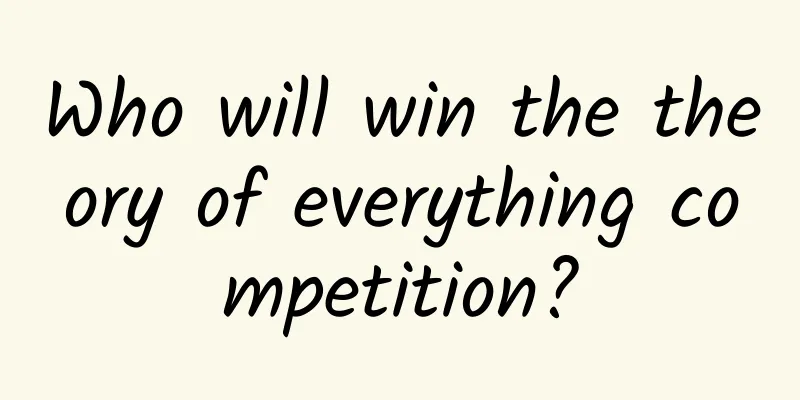Who will win the theory of everything competition?

|
The existing grand unified theory unifies the three interactions except gravity. There is also a theory that attempts to unify the three interactions and all the fundamental particles of matter using entangled quantum information. Physicists have also been pursuing the unification of gravity and other fundamental interactions, and these top minds have proposed many insightful theories. In particular, superstring theory is highly anticipated because its supersymmetry has the potential to be experimentally confirmed, but the most powerful colliders have not been able to produce results so far. Therefore, other theories that attempt to unify are eager to try - we seem to be at the dawn of a new physics. By Leah James Translation | Xia Mengchan, Zhang Yi —Goodbye, Little Susie[1] There is a wise saying that says not to put all your eggs in one basket. Yet, in recent decades, physicists have failed to follow this wisdom. The 20th century, and even the 19th century before it, was a golden age for physicists. They transformed our understanding of the physical world and, therefore, our ability to transform the world around us. Without the knowledge that physicists gained during those two centuries, modern civilization would not exist. The world rewarded them with expensive toys. The Large Hadron Collider (LHC) is the latest: a $6 billion, 27-kilometer-long tunnel near Geneva that opened in 2008. It soon discovered a long-predicted elementary particle, the Higgs boson, a relic of theoretical calculations from the 1960s. Then the LHC set to work on its true purpose: the search for a phenomenon called supersymmetry. Proposed in the 1970s, the theory, known as “Susy” for short, is the catch-all basket into which, until recently, particle physics’ eggs have been laid. On its own, it was supposed to eliminate many of the arbitrary mathematical assumptions required for the so-called Standard Model of particle physics to work properly. But it’s also the vanguard of a deeper hypothesis: string theory, which aims to combine the Standard Model with Einstein’s general theory of relativity. Einstein’s theory explains gravity, while the Standard Model explains the other three fundamental forces — the electromagnetic, weak and strong nuclear forces — and the associated particles. Both describe their own realms of reality pretty well, but they don’t connect. String theory connects them, providing what’s known as a “theory of everything.” Superstrings drive everything Superstring theory holds that the universe is made up of extremely small objects that vibrate in the same way that the strings of a musical instrument do. Like these strings, they have resonant frequencies and harmonics. Superstring theorists believe that these different vibration modes correspond to different elementary particles. These particles include all the particles that have been observed as part of the Standard Model, as well as more particles predicted by Susy. Susy hypothesized that if each particle of the Standard Model had a heavier "supersymmetric" partner particle or "super(symmetric) particle" (sparticle, translator's note: later unified as "superparticle"), then the mathematical fragility of the Standard Model could be eliminated. The graviton is a particle that is necessary to include gravity in any unified theory, but is not predicted by relativity. Yet without Susy there is no string theory. And, 13 years after the LHC opened, no superparticles have emerged. Even two as-yet-unexplained results published earlier this year, one from the LHC and the other from a smaller collider, offer no direct evidence in favor of Susy. As a result, many physicists worry that they have been wasting their time. They had good reason to be anxious. Superstring theory already had a disturbing label conceptually—it added six extra dimensions to the universe (seven in one version) on top of the familiar four (three spatial and one time); it described about 10^500 possible universes, only one of which matched the one we live in. Accepting all that was challenging enough. Without Susy, however, string theory went completely crazy—the number of dimensions exploded to 26. The theory also lost its ability to describe most of the Standard Model particles. That meant there were weird things like (superluminal) particles called tachyons that move faster than light and are therefore incompatible with relativity. Without Susy, string theory as a theory of everything looked pretty much dead. That cleared the way for a non-string theory of everything. Admittedly, many of the non-string theories have names that are a pain in the ass for the English language. They include “causal dynamical triangulation,” “asymptotically safe gravity,” “loop quantum gravity,” and “amplituhedron formulation of quantum theory.”[2] But the bookmakers’ current favorite to unify relativity and the standard model is something called “entropic gravity.” The Monster Inside Entropy is a measure of the disorder of a system. As we all know, the second law of thermodynamics asserts that entropy increases with time (i.e., things have a tendency to become more disordered as time goes on). It may not be obvious how this relates to a theory of gravity, let alone a theory of everything. But the link is black holes. Black holes have gravitational fields so strong that not even light can escape from them. They are predicted by general relativity, and although Einstein was skeptical about their existence until his death in 1955, subsequent observations have shown that they do exist. And they are not "black." In 1974, Stephen Hawking of Cambridge University showed that quantum effects at the boundary of a black hole allow it to radiate particles—specifically, photons, which are particles of electromagnetic radiation, including light. This has unusual consequences. Photons carry radiated heat, so the thing that emits them has a temperature. From its temperature and its mass, it is possible to calculate the entropy of the black hole. This is important because when all these variables are plugged into the first law of thermodynamics, which states that energy can neither be created nor destroyed but can only be converted from one form (such as heat) to another (such as mechanical work), then Einstein's equations for general relativity follow. Erik Verlinde of the University of Amsterdam discovered this relationship in 2010. It has huge implications. The laws of thermodynamics rely on statistical mechanics. The properties they deal with (temperature, entropy, and so on) emerge from a probabilistic description of the behavior of the underlying particles involved. These are also the particles described by quantum mechanics, the mathematical theory that underpins the Standard Model. Einstein’s equations can be reformulated in thermodynamic terms, which means that space and time are also properties that emerge from a deeper, microscopic picture. So it seems that both quantum mechanics and relativity in their current form can, in principle, be derived from a deeper theory that describes the underlying structure of the universe. But string theory doesn’t derive that way, and superstrings aren’t that fundamental an entity yet. But entropic gravity claims to describe the nature of space and time, or “spacetime,” to borrow Einstein’s term. It claims that this is woven together by filaments of “quantum entanglement” that connect every particle in the universe. The idea of quantum entanglement—another phenomenon that Einstein scoffed at but was proven correct—dates back to 1935. It is the property of two or more objects that are related ("entangled") in some way, meaning they can't be described independently. This can cause strange effects. In particular, two entangled particles can affect each other's behavior instantaneously even if they are far apart. Einstein called this behavior "spooky action at a distance" because it seemed to violate the premise of relativity, which states that the universe has a speed limit—the speed of light. As with black holes, Einstein didn’t live to see the day when he was proved wrong. But experiments do show that he was wrong. Entanglement is real and does not violate relativity because, although the influence of one particle on another is instantaneous, the effect cannot be used to transmit information faster than the speed of light. And over the past five years, Brian Swingle of Harvard University and Sean Carroll of Caltech have begun to use ideas from quantum information theory to construct models of how Dr. Verinder’s ideas might work in practice. Their approach is to replace entangled particles with bits of quantum information, so-called “quantum bits,” or qubits. The result is a simple but information-rich analogue of spacetime. Qubits, the quantum equivalent of classical bits—the 1s and 0s on which conventional computing is based—are very familiar to researchers in the field of quantum computing. They are the foundation of quantum information theory. Qubits have two properties that distinguish them from conventional bits. First, they can be put into a state of "superposition," representing both 1 and 0 at the same time. Second, several qubits can be entangled together. These properties enable quantum computers to perform multiple calculations at the same time, or to perform certain specific calculations in a reasonable amount of time that would be difficult or even impossible for a normal computer to perform. According to Swingel and Carroll, because qubits are entangled, they can also be used as a stand-in for how reality works. The more tightly entangled the qubits are, the closer the particles are at corresponding points in space-time. So far, quantum computers are still under development, and this modeling can only be done through mathematical representations of qubits. However, they seem to obey the equations of general relativity. This supports the claims of the entropic theory of gravity. “Wealth and honor are sought in danger” All of these models put entropic gravity in a favorable position to replace string theory as the long-sought theory of everything. But the view that spacetime is an emergent property of the universe, rather than a fundamental property of it, has a disturbing consequence. It obscures the nature of causality. In the picture that entropic gravity creates, spacetime is a superposition of multiple states. It is this that obscures cause and effect. The branch of mathematics that best describes spacetime is a form of geometry that has four axes at right angles to each other, rather than the more familiar three. The fourth axis represents time, so, like the positions of objects, the order of events in spacetime is determined by geometry. If different geometric arrangements add up, as entropic gravity requires, then sometimes it is true that both “A causes B” and “B causes A” are true. This isn’t just speculation. In 2016, Giulia Rubino at the University of Bristol in the UK set up an experiment involving polarised photons and prisms that replicated exactly this scenario. This spells trouble for those who hold old-fashioned ideas about the nature of causality. However, Lucien Hardy of the Perimeter Institute for Physics in Canada has found a way to reformulate the laws of quantum mechanics to overcome this difficulty. To him, causality as it is commonly understood is like data compression in computing: a price-for-money concept that allows causality to infer a lot about the future from just a little information about the present — compressing the amount of information needed to capture the details of a physical system in time. But Dr. Hardy thinks that causality may not be the only way to describe such correlations. Instead, he has invented a general method for building descriptions of patterns of association from scratch. This approach, which he calls the causaloid framework, tends to reproduce causal relationships but does not assume them. He used this approach to reformulate quantum theory (2005) and general relativity (2016). Causal mathematics is not a theory of everything. But there is a good chance that, if such a theory is discovered, it will likely require a causaloid principle to describe it, just as general relativity requires a four-dimensional geometry to describe space-time. Probability Amplitude Modulation Entropic gravity, therefore, has a lot of heavy conceptual work to support it. But it’s not the only candidate to replace string theory. Others vying for attention include an old rival called loop quantum gravity, first proposed in 1994 by Carlo Rovelli, then at the University of Pittsburgh, and Lee Smolin of the Perimeter Institute. This theory, along with causal dynamical triangulation — a later but similar idea — says that spacetime is not the smooth structure that general relativity asserts, but has a structure that is essentially loops or triangles, depending on which you support. The third option – asymptotically safe gravity – dates back even further, to 1976, and was proposed by Steven Weinberg, one of the main architects of the Standard Model. A natural way to develop a theory of quantum gravity would be to add gravitons to the model. Unfortunately, this approach doesn’t work because the math seems to make no sense when the interactions of these postulated particles are calculated at higher energies. However, Weinberg (who died in July this year) argued that this apparent breakdown would disappear (in mathematical parlance, the calculations would be “asymptotically safe”) if the calculations were performed using sufficiently powerful computers. And, with the recent advent of supercomputers of this power, it looks like he was right, judging by early results. However, one of the most interesting competitors to entropic gravity is the amplituhedron form of quantum theory. This was proposed in 2013 by Nima Arkani Hamed of the Institute for Advanced Study in Princeton and Jaroslav Trnka of the University of California, Davis. They discovered a class of geometric structures called amplituhedrons, each of which encodes the details of possible quantum interactions. These, in turn, are the faces of the "master" amplituhedron, which encodes every possible physical process. It is therefore possible to reformulate all of quantum theory in terms of amplituhedrons. Most attempts at a theory of everything try to fit gravity into quantum theory. Einstein described gravity through geometry, but quantum theory does not rely on geometry in the same way. The probability amplitude polyhedron approach does the opposite, arguing that quantum theory is actually deeply rooted in geometry. Even better, the probability amplitude polyhedron is not based on concepts of spacetime or even statistical mechanics. Instead, these ideas emerge naturally from them. So while the probability amplitude polyhedron approach does not yet provide a complete theory of quantum gravity, it opens up an intriguing path that could lead to quantum gravity. The idea that space, time, and even causality are emergent rather than fundamental properties of the universe is a radical one, but it is precisely the point. The revolutions in physics of the 20th century—general relativity and quantum mechanics—are seen as profound precisely because they upended common sense. Accepting relativity meant abandoning common notions of time and space, and taking quantum mechanics seriously meant getting used to ideas like entanglement and superposition. Embracing entropic gravity or its replacement will require a similar leap of imagination. Yet without data, any theory is worthless. That, after all, is the dilemma of supersymmetry. Work like Dr. Rubino’s points the way, and something outside the particle physics lab would be welcome. And, while their implications are unclear, the past few months have seen two experiments that have caused cracks in the Standard Model. On March 23, a team at CERN, the European Organization for Nuclear Research that runs the LHC, reported unexpected differences in the behavior of electrons and their heavier cousins, the muons. The two particles have no known properties different from each other except their mass. The Standard Model predicts that when other particles decay into them, there should be equal numbers of them. But that doesn't seem to be true. Interim results from the LHC show that a particle called the B-meson is more likely to decay into electrons than muons. This suggests that an unknown fundamental force is missing from the Standard Model. Then, on April 7, Fermilab, the largest particle physics facility in the United States, announced interim results from its own muon experiment, Muon G-2. In the quantum world, there is no perfect vacuum - bubbles of particles are constantly created and annihilated everywhere in space and time. These are "virtual" rather than "real" particles - that is, they are fleeting fluctuations that arise directly from quantum uncertainty. Although they are short-lived, they can still interact with more permanent matter during their existence. For example, they are the source of the radiation predicted by Hawking's black holes. The Standard Model predicts how strongly they interact with more conventional matter than black holes. To test these predictions, the Muon G-2 experiment fired muons into a powerful superconducting magnetic storage ring. The quantum foam changes the way the muons quiver, and detectors can detect it with incredible precision. The Muon G-2 experiment showed that the interaction causing these quiverings is slightly stronger than predicted by the Standard Model. If confirmed, this would mean that the Standard Model is missing one or more fundamental particles. breaking Dawn There is a small chance that these are the missing superparticles. If so, supersymmetry supporters would have the last laugh. But with no evidence pointing in that direction, and having so far failed to make their case, they have wisely kept silent. Whatever the cause of these two results, they suggest that there is something that cannot be explained by existing explanations. The same unexplained anomalies are the starting point of quantum theory and relativity. So, one of physics' longest dark nights looks very likely to be ushering in a new dawn. Notes [1] The word “Susy” in the title is a pun, referring to the theory of supersymmetry (SUSY). [2] The amplitude polyhedron was introduced by Arkani-Hamed and Trnka in 2013, and it is speculated that its geometry determines the scattering amplitudes in certain types of quantum field theory. See: N. Arkani-Hamed and J. Trnka, The Amplituhedron, arxiv.org/abs/1312.2007 Original title: Physics seeks the future Original link: https://www.economist.com/science-and-technology/physics-seeks-the-future/21803916 |
<<: These 5 types of cancer may be caused by what you eat!
>>: Digging some wild vegetables, and poof, I got COVID-19?!
Recommend
The curling competition is getting hot! Do you understand these "curling languages"?
February 2, 20:05 Beijing Winter Olympics Curling...
The iPad's decline is just the beginning. The tech industry is doomed by a lack of creativity.
"The biggest enemy in life is not others, bu...
How to quickly create a small program? How to create your own mini program?
How to quickly create a small program? How to cre...
Is it expensive to develop a Sanya nail art mini program? Sanya nail art applet development cost and process
Sanya nail art applet development price 1. Displa...
Why do airplanes run on kerosene, cars run on gasoline, trucks run on diesel, and ships run on heavy fuel oil?
Why do airplanes run on kerosene, cars run on gas...
Is it really good for diabetics to drink camel milk?
Compiled by: Gong Zixin We know that people with ...
What is the secret behind TikTok’s explosive user growth?
Think first: How do you measure user growth ? Wha...
Look! Here is a group of "sponge sheep" that can photosynthesize
When exploring the world of marine life, most peo...
Image processing and performance optimization under iOS
In mobile development, we often deal with multime...
Analysis of 10 hot-selling brands that swept the screen
Today, with the emergence of new marketing concep...
Senior NeXT/Apple developer praises Swift 1.2
Wil Shipley is a senior developer who worked at N...
The most common fossil, many people can't even pronounce its name
Most people may not even know how to pronounce th...
There are so many benefits to sunbathing for a while every day! It is simply a free "health supplement"
How much Sichuan people love to sunbathe When the...
Can’t come up with notes for popular articles on Xiaohongshu? 5000-word complete guide!
"Hey, my notes have had poor traffic recentl...




![[Pearl Science] A Scientific Look at Nano Pearl Powder](/upload/images/67f2a38b06aa6.webp)




